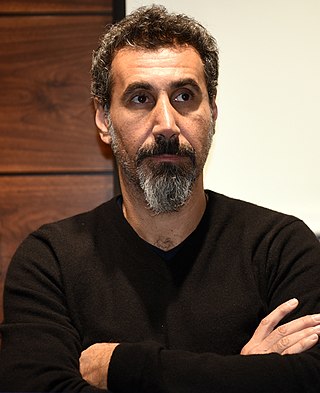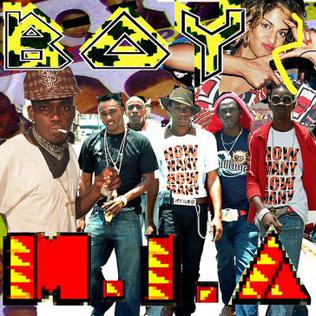A music video is a video that integrates a song or an album with imagery that is produced for promotional or musical artistic purposes. Modern music videos are primarily made and used as a music marketing device intended to promote the sale of music recordings. These videos are typically shown on music television and on streaming video sites like YouTube, or more rarely shown theatrically. They can be commercially issued on home video, either as video albums or video singles. The format has been described by various terms including "illustrated song", "filmed insert", "promotional (promo) film", "promotional clip", "promotional video", "song video", "song clip", "film clip", "video clip", or simply "video".

Serj Tankian is an Armenian-American musician and songwriter. He is best known as the lead vocalist, keyboardist, rhythm guitarist and primary lyricist of System of a Down, which was formed in 1994.

Heather B. Gardner, billed professionally as Heather B., is an American rapper, reality television personality, and a radio host who first gained fame as a member of the hip hop group Boogie Down Productions before becoming a cast member on The Real World: New York, the 1992 inaugural season of MTV's reality show The Real World.

"Sunshowers" is a song by British musician M.I.A. from her debut studio album, Arular. It was written and produced by Maya "M.I.A." Arulpragasam, Ross Orton, Steve Mackey, August Darnell and Stony Jr. Browder, with additional vocals and production by Nesreen Shah and Anthony Whiting. The song was released as the second single of the album on 7 July 2004 following the 2003 release of debut "Galang" and is M.I.A.'s first official release with XL Recordings. Released in vinyl record and CD single format, with the song "Fire Fire" serving as the song's B-side, "Sunshowers" was distributed by Interscope Records in the US.
Graphic violence refers to the depiction of especially vivid, brutal and realistic acts of violence in visual media such as film, television, and video games. It may be real, simulated live action, or animated.

Censorship on MTV has been the subject of debate for years. MTV, the first and most popular music television network in the U.S., has come under criticism for alleged censorship in their programming. Throughout the decades, MTV has altered or removed shows from the channel's schedule to address complaints; and music videos have been censored, moved to late-night rotation, or banned from the channel's rotation for various types of controversial content.

"Boyz" is a song recorded by artist M.I.A. for her second album Kala (2007). The song was written and produced by Maya "M.I.A." Arulpragasam and Dave "Switch" Taylor and composed in recording sessions held in several countries. A combination of the native styles and influences of these regions and her traditional and electronic musical roots, the song sees M.I.A. mock and simultaneously praise men for various character traits. "Boyz" was one of the first songs that the artist composed for the album and was released as the album's lead single through XL Recordings and Interscope Records on 11 June 2007, in 12-inch single, CD single, digital download and USB flash drive formats. It additionally appeared in an enhanced EP format for its CD single release, and appeared on the How Many Votes Fix Mix EP edition. On 24 April 2007, "Boyz" received its world premiere on the BBC Radio 1 radio station in London.

"Paper Planes" is a song by British hip hop artist M.I.A. It was released on 11 February 2008 as the third single from her second studio album, Kala (2007). It is produced and co-written by her and Diplo. It appeared in the 2008 film Slumdog Millionaire and on its soundtrack album. The song samples English rock band the Clash's 1982 song "Straight to Hell", leading to its members being credited as co-writers. A downtempo alternative hip hop, pop track combining African folk music elements, the song has a less dance-oriented sound compared to other songs on the album. Its lyrics, inspired by M.I.A.'s own problems obtaining a visa to work in the USA, satirise American perceptions of immigrants from Third World nations.

Romain Gavras is a French director. He is known for directing M.I.A.'s videos "Bad Girls" and "Born Free", Kanye West and Jay-Z's video "No Church in the Wild" and Jamie xx's video "Gosh". He also directed Justice's "Stress".

Mathangi "Maya" Arulpragasam, known by her stage name M.I.A., is a British rapper, record producer, and singer. Her music combines elements of alternative, dance, electronic, hip hop and world music with electronic instruments and samples.

"Born Free" is a song by English Tamil recording artist M.I.A., released alongside an accompanying short film/music video of the same name from her third album, Maya. XL Recordings and Interscope Records/N.E.E.T. released "Born Free" as a digital download from the album on 23 April 2010, with the music video released on 26 April 2010. "Born Free" was written and produced by Maya "M.I.A." Arulpragasam and Dave "Switch" Taylor. The artwork for the single was released on 25 April 2010.

"XXXO" is a song by English recording artist M.I.A., released as the lead single from her third studio album, Maya (2010). The song was written by M.I.A., Charles "Blaqstarr" Smith and Cherry Byron-Withers, and produced by Blaqstarr and Rusko. "XXXO" was first released as a digital download following its world premiere on radio on 10 May 2010, and released in physical format in the United Kingdom on 28 June 2010. Two XXXO remix EPs were released alongside the single, featuring Jay-Z, SBTRKT, KickRaux amongst others on official remixes. The song's release followed the digital release of "Born Free", also from Maya.

Maya is the third studio album by British rapper M.I.A., released on 7 July 2010 on her own label, N.E.E.T. Recordings, through XL Recordings and Interscope Records. Songwriting and production for the album were primarily handled by M.I.A., Blaqstarr and Rusko. M.I.A.'s long-time associates Diplo, Switch and her brother Sugu Arulpragasam also worked on the album, which was mainly composed and recorded at M.I.A.'s house in Los Angeles. The album's tracks centre on the theme of information politics and are intended to evoke what M.I.A. called a "digital ruckus"; with the album, elements of industrial music were incorporated into M.I.A.'s sound for the first time. A deluxe edition was released simultaneously, featuring four bonus tracks.

"Space Bound" is a song by American rapper Eminem. It was released on June 18, 2011, as the fourth and final single from his seventh album, Recovery. The song is produced by American hip-hop producer Jim Jonsin and features samples of "Drive" by R.E.M., "Song for Bob" by Nick Cave and Warren Ellis.

The music video for Barbadian singer Rihanna's 2011 single "We Found Love" was directed by Melina Matsoukas. It was filmed on September 26–28, 2011, in the New Lodge area of Belfast and Bangor, County Down, Northern Ireland. People driving around the location of the set informed BBC that traffic in the area was congested as drivers wanted to see the singer. The video premiered on October 19, 2011, and was made available to download digitally three days later on October 22. As of July 2023, the video has amassed over 1 billion views on YouTube.

"Bad Girls" is a song by British recording artist M.I.A. for her fourth studio album, Matangi (2013). The song is written by Maya "M.I.A." Arulpragasam, Marcella Araica and Floyd Nathaniel "Danja" Hills, and produced by Danja. The song, Arulpragasam's first release following her departure from the UK's XL Recordings in 2011, was self-released worldwide under exclusive license to Interscope Records in the US on 31 January 2012. A shorter version of the song appeared on Vicki Leekx, a mixtape released for free online on 31 December 2010. "Bad Girls" was released as a digital download a day after its world premiere on radio and online.
Paramount Global is an American multinational entertainment conglomerate that was the subject of criticisms and controversies about its products and services. Criticism of Paramount Global has included the former Viacom Inc.'s announced plans of looking into splitting the company into two publicly traded companies. The company was not only dealing with a stagnating stock price, but also the rivalry between Leslie Moonves and Tom Freston, longtime heads of MTV Networks. In addition, the company was facing issues after MTV was banned from producing any more Super Bowl halftime shows after the Super Bowl XXXVIII halftime show controversy in 2004.

Pia Mia Perez is an Chamorro singer, songwriter, and model. She began her career posting song covers on YouTube, after which she was discovered by American singer Babyface in 2010. Three years later, she signed with Interscope Records and worked closely with record producer Nic Nac to release her debut extended play (EP), The Gift (2013), which gained popularity from and included her cover of Drake's 2013 single, "Hold On, We're Going Home".
Mia Khalifa is a Lebanese-American media personality and former pornographic film actress and webcam model. Born and raised in Lebanon, she and her family relocated to the United States in 2001. She entered the sex industry in October 2014, becoming the most viewed performer on Pornhub in two months. Her career choice was met with controversy after the release of a video in which she is engaged in a threesome while wearing a hijab; the scene brought Khalifa instant popularity as well as criticism from writers and religious figures. In 2015, Khalifa was voted the "Number 1 Porn Star" on Pornhub. In January 2017, xHamster reported that she was the most-searched-for adult actress of 2016. In 2018, she became the most-searched-for actress on Pornhub.

"Borders" is a song by recording artist M.I.A. for her fifth studio album, AIM (2016). The track was written by M.I.A., Levi Lennox and Amish Patel, and has been described as an electronic song incorporating such musical styles as hip hop and world music.

















